Reflections on Woman’s Medical College and the 1918 Flu Pandemic
Compiled by Nancy West
The story of the Woman’s Medical College of Pennsylvania (WMCP), a predecessor institution of Drexel University College of Medicine, and the 1918 influenza pandemic is one of uncommon valor, volunteerism and, ultimately, victory over this deadly disease.
When the pandemic hit Philadelphia in the fall of 1918, WMCP was already struggling to keep up with patient care because so many staff members had gone to help on the front lines of World War I.
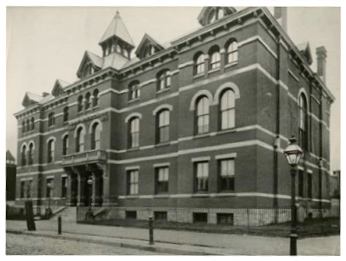
Woman’s Medical College of Pennsylvania on North College Avenue in Philadelphia (circa 1920)
Even so, WMCP faculty, staff and students were involved in fighting the pandemic from the very start. The Woman’s Hospital began treating influenza patients on September 18, the same day the city reported its first diagnosed case. By September 23, the College Hospital, located next door, had cleared out as many rooms as possible for incoming patients. A week later, WMCP canceled classes so faculty, staff and students could treat patients. Normal student life didn’t resume at WMCP until the end of October.
All Hands on Deck
Influenza cases grew rapidly and hospital staff soon started to fall ill with the flu. Medical students stepped up to volunteer, despite not necessarily being trained in the areas where help was needed. As one report from 1919 indicates:
“It would have been impossible to carry the volume of work which presented had it not been for the splendid cooperation of our medical students, our newly entered probation class in nursing, our nurses’ aides, trained last year in our wards, and last, but by no means least, the splendid body of volunteers... No hospital was ever so fortunate in the response of women to its need!”
Unknown Author, “Bulletin of the Woman’s Medical College of Pennsylvania,” Vol. 69, December 1918:
“... young medical students became our most relied-upon night nurses; laboratory physicians became practitioners of medicine for the period of the emergency; probationer nurses, hardly twenty-four hours old in the profession, worked most dependably throughout the trying days...”
Accounts From Dean Tracy
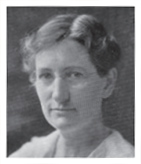
Martha Tracy, MD, WMCP 1904, dean of WMCP from 1917 to 1940 (1918)
Martha Tracy, MD 1904, dean of WMCP and member of the Alumnae Association of WMCP, at the 44th Annual Meeting of the Alumnae Association of WMCP in June 1919:
“In September, after one week of college work, the epidemic of influenza, like a specter of death, was upon us almost overnight, and three days after the disease was made reportable by the Board of Health our hospital was full to overflowing with victims of the pestilence, and our Senior, Junior and Sophomore students were released from class work and mobilized for hospital service.”
“Within a week our gymnasium became a hospital ward, where students and nurses who succumbed while serving on the battle front were cared for.”
“We record with thankfulness that we lost no one of our doctors or students in that battle, and with sorrow, that one faithful nurse laid down her life on the field of duty.”
“It is unnecessary to dwell on the nightmare of the five weeks which followed [the start of the pandemic]. You know how our doctors and students, with no thought of self, labored day and night in that death struggle, and members of our Board of Corporators stood with them, daily serving as nurses’ aides, dieticians or clerks, wherever the need was greatest.”
Making Do With Limited Supplies
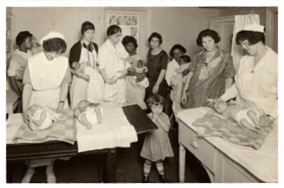
Woman’s Medical College of Pennsylvania mothers and babies clinic (1918)
Unknown Author, “Bulletin of the Woman’s Medical College of Pennsylvania,” Vol. 69, December 1918:
“It was truly like unto the rush of the wounded from the field of battle, and the house was filled to capacity almost at once. Within a few days it was necessary to open a ward in the College gymnasium, which was equipped with beds from our students’ dormitory, the ambulance gathering both the beds and the patients and bringing them into the hospital… Sheets, lent by the Red Cross, played the role of curtains and table covers; stools, dedicated to the sacred precincts of…laboratories, served as bedside tables; and … the nurses were merely camouflaged medical students.”
Heroic Work on the Front Line
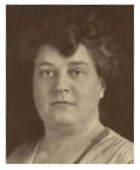
Mary Buchanan, MD, WMCP 1899, clinical professor of opthalmology at WMCP (1919)
Mary Buchanan, MD 1899, clinical professor of ophthalmology at WMCP, ophthalmology medical staff member at the Woman’s Hospital of Philadelphia and 1917 and 1918 president of the Alumnae Association of WMCP, at the 44th Annual Meeting of the Alumnae Association of WMCP in June 1919:
“The scarcity of doctors and the dearth of nurses threw an awful burden on those left in civil life. The acts of heroism of some of our women doctors will never be known, but the devotion to duty while those nearest and dearest to them were dying and dead, too far away for them to reach them, was worthy of an epic I am unable to write. Even as her poor tired heart seemed as if it could not stand the added strain of the death of two dear brothers the same day of the dread plague, one brave doctor said she would be willing to die if she were able to save the mother of eight children who had aborted and had pneumonia. Fortunately, her own life did not pay the penalty and the children were not orphans.”
Pregnant Patients: Addressing a Special Risk
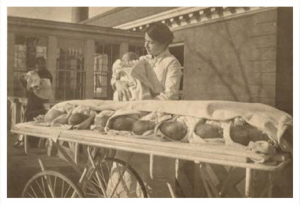
Florence Weaver, MD, WMCP 1911, at Woman’s Medical College of Pennsylvania Hospital (1918)
Florence E. Kraker, MD 1905, acting obstetrician-in-chief at the WMCP Hospital, WMCP clinical professor of obstetrics and member of Alumnae Association of WMCP, date unknown:
“During the influenza epidemic, because of the extreme susceptibility of pregnant women, it was felt to be safer not to admit patients having the disease to the maternity. All cases of influenza complicating pregnancy were taken into the main hospital. In this way we maintained our maternity free from the infection, and so were able to offer a safe place in which our patients could have their babies.”
WMCP’s efforts worked in their favor even with the maternity department seeing an increase in cases at the start of the flu epidemic. Throughout the 1918-1919 period, 224 babies were delivered, which included eight pairs of twins. The maternity department did not lose one case to the flu or pneumonia.
2021 Alumni Weekend Event: Drexel’s Response to the 1918 Pandemic
During the College of Medicine’s 2021 Alumni Weekend, panelists discussed many aspects of WMCP’s response to the 1918 pandemic. The panelists included:
- Steven J. Peitzman, MD, FACP, Professor of Medicine, Drexel University College of Medicine
- Clare Sauro, Director & Chief Curator, Robert and Penny Fox Historic Costume Collection at Drexel University
- Matthew Lyons, University Archivist, Drexel University Libraries, Drexel University
- Jennifer Vess, The Brooke Dolan Archivist, Library and Archives, Academy of Natural Sciences of Drexel University
- Matt Herbison, Archivist, Legacy Center: Archives & Special Collections, Drexel University College of Medicine
- Margaret Graham, Director, Legacy Center: Archives & Special Collections, Drexel University College of Medicine
This piece drew heavily from articles written by:
- Alissa Falcone, editor and staff writer, DrexelNow and Drexel Quarterly
- Ari McManus, Legacy Center public history virtual intern, summer/fall 2020
- College of Arts & Sciences students María Paula Mijares (Communications) and Kejsi Ruka (Global Studies), and LeBow College of Business student Daniel Yi (Economics/Finance)
We are grateful for their contributions.
Back to Top